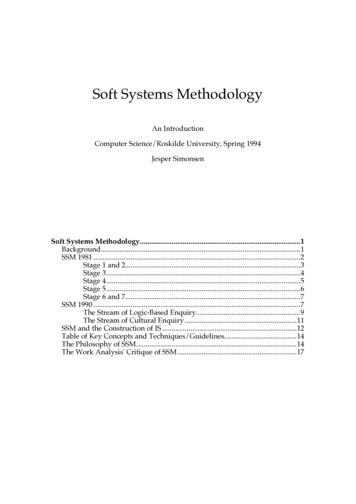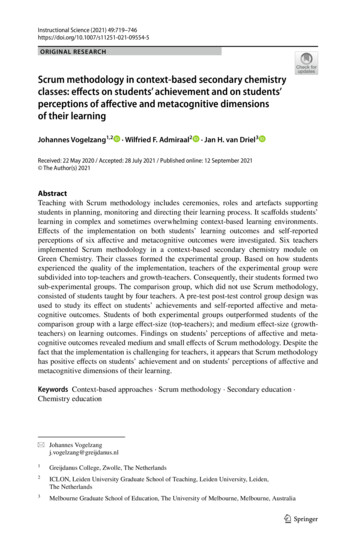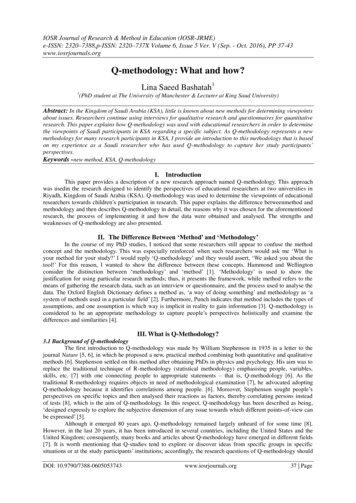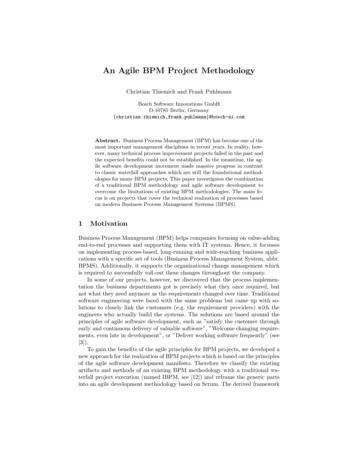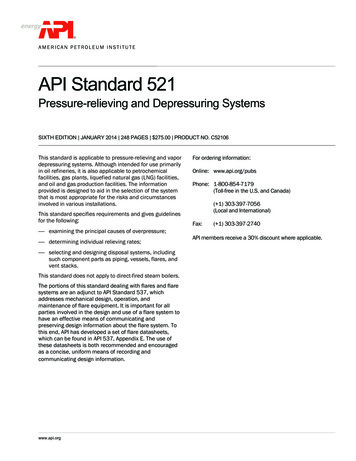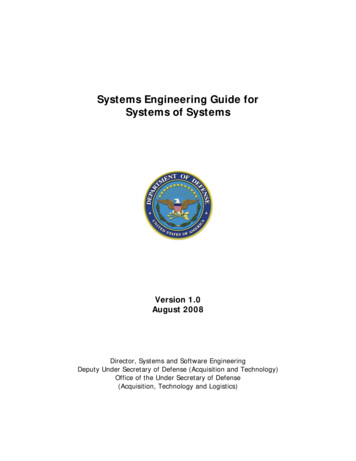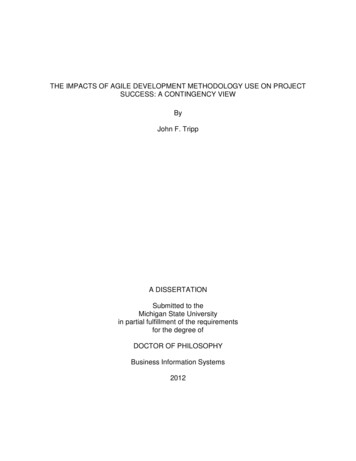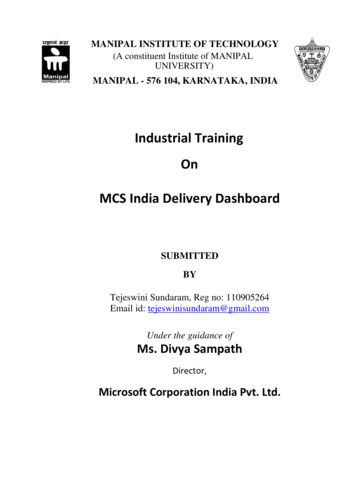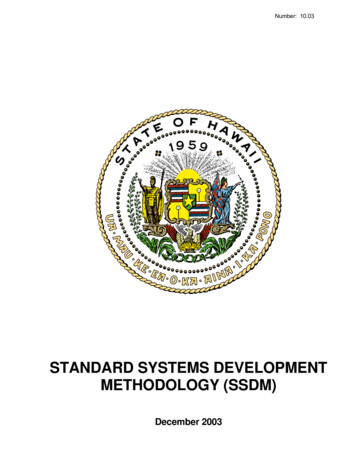
Transcription
Number: 10.03STANDARD SYSTEMS DEVELOPMENTMETHODOLOGY (SSDM)December 2003
Number: 10.03Effective: 12/01/2003TABLE OF CONTENTS1INTRODUCTION .11.1PURPOSE .11.2OVERVIEW .11.3SCOPE .11.4COMMENTS AND SUGGESTIONS .22SSDM OVERVIEW .32.1STATE SYSTEM DEVELOPMENT LIFE CYCLE .32.1.1 STANDARD SYSTEM LIFE CYCLE .32.1.2 PURCHASED PACKAGE SYSTEM LIFE CYCLE .32.1.3 LIMITED SYSTEM LIFE CYCLE .32.1.4 SYSTEM MAINTENANCE.32.1.5 SYSTEM ENHANCEMENT .32.1.6 USE OF SPECIAL TECHNIQUES .42.2SSDM TASK LISTS BY PHASES.42.2.1 SRD WORK PLAN.42.2.2 SDA WORK PLAN .72.2.3 SES WORK PLAN .102.2.4 SIS WORK PLAN .132.2.5 PD WORK PLAN .162.2.6 TST WORK PLAN .182.2.7 CNV WORK PLAN.202.2.8 IMP WORK PLAN .222.3SSDM DOCUMENTATION REQUIREMENTS BY PHASES .242.3.1 SYSTEM REQUIREMENTS DEFINITION PHASE .242.3.2 SYSTEM DESIGN ALTERNATIVES PHASE .252.3.3 SYSTEM EXTERNAL SPECIFICATIONS PHASE .262.3.4 SYSTEM INTERNAL SPECIFICATIONS PHASE .282.3.5 PROGRAM DEVELOPMENT PHASE .292.3.6 TESTING PHASE.292.3.7 CONVERSION PHASE .302.3.8 IMPLEMENTATION PHASE .313WAIVER PROCEDURE .323.1AGENCY PROJECT OR AGENCY OVERALL REQUEST FOR EXEMPTION (WAIVER) FROMSSDM .323.2CONSULTANT PROJECT WAIVER FROM SSDM.333.3RFP’S LANGUAGE .333.3.1 PROCUREMENT PROCESS SECTION .333.3.2 METHODOLOGY FOR DEVELOPING SECTION .353.3.3 PROPOSAL DUE DATE SECTION .363.3.4 AUTHORIZATION TO UTILIZE ANOTHER METHODOLOGY SECTION .363.3.5 SUPPORTING DOCUMENTATION SECTION .37APPENDIXStandard Systems Development Methodology (SSDM)Rel: December 01, 2003Page i
Number: 10.03Effective: 12/01/2003Department of Accounting and General ServicesInformation and Communication Services DivisionInformation Technology Standards1 INTRODUCTIONThis document contains the State of Hawaii Executive Branch of Government'sStandard Methodology for developing systems.IT Standards consist of the Executive Branch IT policies, standards, procedures,conventions, and guidelines for the development of application systems.The standard methodology must be applied to all systems developed for use by theExecutive Branch, including consultants who are developing applications for informationprocessing and communications applications for Executive Branch agencies, unlesswaiver of the standard is received from the Information and Communication ServicesDivision (ICSD) Administrator.1.1PurposeThe purpose of this document is to present a standardized approach todeveloping application systems.Another goal of this document is to promote consistency in the development ofapplication systems.1.2OverviewThe Standard Systems Development Methodology (SSDM) evolved fromSDM/Structured, a proprietary manual set developed by AGS ManagementSystems who went out of business in 1999. SDM/Structured (thus SDDM) isobsolete and does not contain sufficient information on Rapid ApplicationDevelopment (RAD), Joint Application Development (JAD) workshops in place ofinterviews, or information engineering. SDM/Structured (thus SSDM) is formsdependent. SDM/Structured consists of thirteen manuals, has no automated tools,and is generally a good methodology, as a traditional approach to development bycost-committed phases. ICSD has been unable to acquire a new standardmethodology due to funding shortfalls. However, SSDM remains the standard thatmust be followed if it is not waived for use by Executive Branch agencies andconsultants.1.3ScopeThe scope of this document is a description of the SSDM and waiver requestrequirements to use another methodology by project or agency.Standard Systems Development Methodology (SSDM)Rel: December 01, 2003Page 1
Number: 10.03Effective: 12/01/2003Department of Accounting and General ServicesInformation and Communication Services DivisionInformation Technology Standards1.4Comments and SuggestionsAny State of Hawaii Information Technology Standards document, referencemanual or users guide mentioned in this document are available through thedepartmental user agency data processing coordinator (DP Coordinator).Standards are also accessible on-line by clicking on Information TechnologyStandards on the ICSD home page at:http://www.hawaii.gov/icsd/Statewide Forms are accessible on-line by clicking on Forms Central on theGovernment in Hawaii home page nts, recommendations, proposals, or suggestions regarding the contents ofthis document may be sent either via email to icsd.admin.ppmo@hawaii.gov or inwriting to:Information and Communication Services DivisionProject Planning and Management Office1151 Punchbowl Street, B-10Honolulu, Hawaii 96813-3024Standard Systems Development Methodology (SSDM)Rel: December 01, 2003Page 2
Number: 10.03Effective: 12/01/2003Department of Accounting and General ServicesInformation and Communication Services DivisionInformation Technology Standards2 SSDM OVERVIEW2.1State System Development Life CycleThe following system development life cycles are supported by the statestandard through the Information and Communication Services Division (ICSD):2.1.1 Standard System Life Cycle Phase 1: Phase 2: Phase 3: Phase 4: Phase 5: Phase 6: Phase 7: Phase 8:System Requirements Definition (SRD)System Design Alternatives (SDA)System External Specifications (SES)System Internal Specifications (SIS)Program Development (PD)Test (TST)Conversion (CNV)Implementation (IMP)2.1.2 Purchased Package System Life CycleThe Purchased Package Life Cycle is the same as the Standard SystemLife Cycle except that the SES, SIS and PD phases are performed only forthe system modifications that may be required to meet the operational andother requirements of the system.2.1.3 Limited System Life CycleThe Limited System Life Cycle is a compressed development cycle thatallows for fewer tasks and activities, and documentation requirements forsmall projects of lesser scope, time frame projections, cost, or priority.2.1.4 System MaintenanceThis is the stage to follow Production Implementation but may also beconsidered a Life Cycle.2.1.5 System EnhancementLike Maintenance but larger in scope and objectives and may be a smallor large effort in that a project may follow a small project with the LimitedSystem Life Cycle or a complete Standard System Life Cycle to completea larger enhancement project.Standard Systems Development Methodology (SSDM)Rel: December 01, 2003Page 3
Number: 10.03Effective: 12/01/2003Department of Accounting and General ServicesInformation and Communication Services DivisionInformation Technology Standards2.1.6 Use of Special TechniquesThe ICSD encourages the use of Joint Application Development (JAD)workshops in place of the interview process, and Rapid Application Development(RAD) to do prototyping in the SRD and SDA phases. The ICSD alsoencourages the use of software tools in the development process such asvarious groupware products and ICASE.2.2SSDM Task Lists by PhasesThe following task lists and work-planning checklists are included in this document: System Requirements Definition (SRD) Work Plan System Design Alternatives (SDA) Work Plan System External Specifications (SES) Work Plan System Internal Specifications (SIS) Work Plan Program Development (PD) Work Plan Testing (TST) Work Plan Conversion (CNV) Work Plan Implementation (IMP) Work Plan2.2.1 SRD Work PlanThis phase seeks to identify and documents requirements of the system up front inthe development process.1.Plan SRD Work Tasks1.0Get Management Support To Work On Project1.0.1 Receive Service Request Action Packet1.0.2 Get Management Approvals Request approval to start project Request approval for projected SRD costs and schedules1.1Identify Project Scope1.1.1 Define Scope And Assumptions1.1.2 Define Participants/Users1.1.3 Define High-Level Business ModelStandard Systems Development Methodology (SSDM)Rel: December 01, 2003Page 4
Number: 10.03Effective: 12/01/2003Department of Accounting and General ServicesInformation and Communication Services DivisionInformation Technology Standards List project goals, objectives, assumptions, and restrictionsDesign context diagramsDefine key information about each participating organizationIdentify individuals to be interviewedDevelop business model of areas affected by requested projectGain management approval for project scope 1.2Establish Index To Identify DataDesign indexing level for model for data consisting of:1)required input/output documents2)required reports3)pertinent statistical studies4)Update/maintain index for collected data1.3Conduct Interviews1.3.1 Prepare Questions For Interviews List basic and key questions for person to be interviewed1.3.2 Schedule And Hold Interviews Take notes during each interview conducted1.3.3 Review and Summarize Interviews Formulate exhibits to support requested project Draft data flow and work flow diagrams based on interview contents Consolidate and summarize contents of interviews1.4Document The Current System1.4.1 Build High-Level Model Of Project Draw current (actual) physical data flow diagrams1.4.2 Design Lower-Levels Of Project Model Describe all data flows of interfaces within the system1.4.3 Define Needed Data Stores Describe function for all files Define each data flow and file elements in data dictionary1.4.4 Document Processes And Procedures Analyze data descriptions Analyze major data processes Make process description for major data processes1.4.5 Build Index For Model Levels1.5Analyze Current SystemStandard Systems Development Methodology (SSDM)Rel: December 01, 2003Page 5
Number: 10.03Effective: 12/01/2003Department of Accounting and General ServicesInformation and Communication Services DivisionInformation Technology Standards1.5.1 Design Lowest Level Logical Data Flow Diagrams Describe and analyze current abstract logical data flow diagrams1.5.2 Update Current Element Definitions In Data Dictionary Describe and analyze logical data items in current system1.5.3 Define Current Data Elements Functions1.5.4 Develop Current Data Stores Models Describe and analyze logical data stores models for current files1.5.5 Design Current Data Function Matrix Describe and analyze function descriptions of current systemprocesses1.5.6 Develop Higher Level Logical Data Flow Diagrams1.5.7 Send Current Physical Model For Management Review1.6Define Information Requirements For New System1.6.1 Establish New System Objectives List new system information objectives1.6.2 Identify New System Logical Requirements Identify logical impacts of each new system objectives Specify needed data dictionary updates1.6.3 Design New System Logical Data Models Design new system logical data flow diagrams Define new system information requirements for new functions andprocesses1.6.4 Propose New System Data Stores Models1.7Create And Analyze New System Objectives1.7.1 Rank New System Objectives1.7.2 Define Required Data Characteristics And Attributes Define and rank new physical data requirements Define appropriate data dictionary elements Define new data flow diagrams Define appropriate new functions and descriptions1.7.3 Propose New Physical System Function Requirements1.7.4 Review New System Model For Quality Considerations Review new data models for audit considerations1.7.5 Get Approval For New Ranked System Objectives1.8Prepare SRD Document To Include:I.II.Analysis of current systemNew requirements definitionsStandard Systems Development Methodology (SSDM)Rel: December 01, 2003Page 6
Number: 10.03Effective: 12/01/2003Department of Accounting and General ServicesInformation and Communication Services DivisionInformation Technology StandardsIII.IV.V.1.9Anticipated benefitsSummarize study and recommended systemSupporting data and appendicesProcess SRD Documents Through Review Points1.9.1 Prepare Work Plan and Estimates for SDA Phase1.9.2 Process SRD Work Plan Action Packet For Review and Approval1.9.3 Review SRD Action Packet for Documentation Quality Get approval for SRD recommendation Get approval for estimated SDA costs and schedule Get approval for SRD action packet2.2.2 SDA Work PlanThis phase seeks to define the possible design solutions that will both satisfy therequirements and meet the design constraints.2.0 Review SRD work planReview SRD action documents2.1Identify Design ConstraintsReview lists of system requirements definitions (SRD), project scope,constraints, restrictions, and assumptions concerning the overall systemdesign to identify design alternativesAssess validity of system assumptions, scope, and constraintsDefine audit-related constraints2.2Specify Operational AlternativesDesign high level model for each viable alternative with each consisting of:1)Data flow diagram2)Data dictionary3)Model narrative discussionReview alternatives requiring database interfaces2.3Define Processor Boundaries2.3.1 Specify System Automation Boundaries2.3.2 Define Internal System and External Automated SystemConnections2.3.3 Define Manual FunctionsStandard Systems Development Methodology (SSDM)Rel: December 01, 2003Page 7
Number: 10.03Effective: 12/01/2003Department of Accounting and General ServicesInformation and Communication Services DivisionInformation Technology Standards2.3.4 Allocate Manual Functions Design level set of data flow diagrams for each alternative to showthe allocation of required functions defined in SRD to the appropriateprocessors Refine lists of constraints and assumptions Review viable design alternatives Review and include quality-related criteria in evaluations2.4Evaluate Candidate ProductsDesign detailed evaluation for contending productsAnalyze contending products for final selection considerationSelect final product for approvalDesign recommendation report to managementGenerate recommendation report to managementGet approval for final product2.5Define Automated System Requirements2.5.12.5.22.5.32.5.4 2.6Design Inputs and Outputs for Automated SystemsSpecify Data Input and Output ProcessesDefine Physical Data Store RequirementsDocument Required Administrator ActivitiesFor recommended alternative, provide:1)Augmented data flow diagrams2)Supplemented data dictionary entries3)Modeled physical data stores4)Additional process description detailsDesign narrative highlighting differences fromalternative for each additional alternativeRedefine system design constraintsReview and define control-related requirementsReview data requirementsReview and identify security requirementsReview quality implications of each alternativerecommendedDetermine Estimated Cost Savings And Projected Schedule2.6.1 Determine Tangible Cost Savings Get current operating costs Project future operating costs Determine tangible direct costs2.6.2 Determine Intangible Savings Or ContributionsStandard Systems Development Methodology (SSDM)Rel: December 01, 2003Page 8
Number: 10.03Effective: 12/01/2003Department of Accounting and General ServicesInformation and Communication Services DivisionInformation Technology Standards Project development costs for each alternativeProject start-up costs for each alternative Determine intangible costs2.6.3 Determine ROI And Payback Period Project payback period Project ROI for each alternative2.6.4 Determine Initial Project Schedules Develop projected schedule for each alternative1)Schedule SES for each alternative2)Schedule project completion for each alternative Review cost savings Review validity of return on investment (ROI) Review validity of payback 2.7Identify Trade-offsDesign and compare tabulations for each alternative, including data; costs;ROI; payback period; etc.Compare benefits of each alternativeCompare alternative system design attributesAssess implications for users and organization for each alternativeReview quality-related trade-offs for each alternative2.82.9Prepare SDA Document To Include:I.II.List of alternative solutionsRecommended system design descriptionIII.IV.V.Analysis of data requirementsSummarize study and justify recommendationSupporting data and appendicesProcess SDA Documents2.9.12.9.22.9.32.9.42.9.5Prepare Work Plan and Estimates for SES PhaseProcess SDA Work Plan Action Packet For Review and ApprovalGet approval for SDA recommendationGet approval for estimated SES costs and scheduleGet approval for SDA action packetStandard Systems Development Methodology (SSDM)Rel: December 01, 2003Page 9
Number: 10.03Effective: 12/01/2003Department of Accounting and General ServicesInformation and Communication Services DivisionInformation Technology Standards2.2.3 SES Work PlanThis phase seeks to create the complete system specifications and capture all theuser requirements for the new system, both physical and logical.Review SRD work plan and action packetReview SDA work plan and action packet3.1Establish Automated System Environment3.1.13.1.23.1.33.1.43.1.53.1.63.2 Document Operating EnvironmentSpecify Hardware And Software RequirementsSpecify Hardware And Software ConfigurationsEstablish Allowances For Future ContingenciesPrepare Plan For System's FacilitiesOrder Hardware And Software Define constraints imposed by current operating environment Establish required hardware and software specifications Establish specifications to acquire required but unavailablehardware and software Design allowances for future contingencies Establish specifications and schedules to alter site toaccommodate new hardware Review operating environment and future contingencies Review design approaches and performance constraints Issue contracts and purchase ordersPartition Automated System Into Sub-SystemsDesign partitioned physical automated model to show:1)Data flow diagram for each automated sub-system2)Data dictionary describing sub-system interfaces3)Operating processing descriptions for each sub-system3.3 Document Communications RequirementsDesign sub-system networksDesign communications network for each sub-system network 3.4Design Inputs And Outputs For Each Sub-System3.4.1 Design Data Flows For Each Sub-SystemStandard Systems Development Methodology (SSDM)Rel: December 01, 2003Page 10
Number: 10.03Effective: 12/01/2003Department of Accounting and General ServicesInformation and Communication Services DivisionInformation Technology Standards 3.4.2 Specify Data Transportation Processes3.4.3 Establish Data Control Mechanisms Design format of automated data inputs and outputs Design descriptions of automated data inputs and outputs Design automated data input and output process descriptions3.4.4 Design data flow control measures to insure:1)Data completeness2)Data correctness3)Data reliability4)Data availability5)Data audit controls3.4.5 Review data flow controls3.4.6 Review data security requirements3.5Design Automated Data Stores 3.5.13.5.23.5.33.5.43.6Establish Data File StructuresSpecify Data Management RequirementsIdentify Stored Data Integrity And Security RequirementsSpecify Data File Maintenance Processes.Design data table contents and layouts.Design file contents and layouts.Design logical database schema Design automated file maintenance process descriptions Design control measures to ensure stored data integrity Design measures to ensure data control Review data file elements Review logical database schema Review integrity for data stores Review security requirements Review data file maintenance processesDesign Administrative Activities3.6.13.6.23.6.33.6.4Design Data Entry And Data Destination ProceduresEstablish Data Audit And Data Security ProceduresSpecify File Construction And Reconstruction ProcessesPrepare Plans For Users' Guides Design manual/telecommunications procedures andprocesses to support new automated system, includingprocedures for:1)Data entry and data collection2)Data output distributionStandard Systems Development Methodology (SSDM)Rel: December 01, 2003Page 11
Number: 10.03Effective: 12/01/2003Department of Accounting and General ServicesInformation and Communication Services DivisionInformation Technology Standards 3.7Prepare Test Data; Prepare System Test Cases; Prepare System And DataConversion Plans; And Prepare Implementation Plans3.7.13.7.23.7.33.7.43.7.53.83)Data file construction, recovery, or reconstruction4)Data control, audit, and security measuresDesign data control schematicsDesign messages to summarize data processingDesign users' guidesReview procedural requirementsReview data control proceduresReview data security proceduresReview file construction proceduresReview file recovery proceduresIdentify Test Case Criteria For System AcceptanceDevelop Preliminary System Test PlanDevelop System Test and Data Conversion PlansDevelop System Implementation PlanDevelop Training Plans Design system acceptance criteria Design preliminary test plan Design system and data conversion plans Design system implementation plan Design training plan Review system acceptance criteria and related plans Review system test plans Review system conversion plans Review system implementation plan Review interface systems test plans Review training plans Walk through system external specification designPrepare SES Document To Include:I.II.III.IV.V.VI.VII.VIII.IX.Management Summary of System DesignSystem Design Detail SpecificationsSystem Security; Data Controls; Data Auditability SpecificationsSystem Processes and Procedural RequirementsTesting; Conversion; Implementation PlansPreliminary Operations Data (content and layout)External Systems Interface RequirementsSupporting Data and AppendicesAutomated System Requirements ChangesStandard Systems Development Methodology (SSDM)Rel: December 01, 2003Page 12
Number: 10.03Effective: 12/01/2003Department of Accounting and General ServicesInformation and Communication Services DivisionInformation Technology StandardsX.3.9Planned Users' Guides OutlinesProcess SES Document and Reviews3.9.1 Process SES Work-Plans3.9.2 Estimate Costs and Schedules for SIS Phase3.9.2 Process SES Documents for Review and Approval Get SES action packet approved Get costs and schedules for SIS phase approved2.2.4 SIS Work PlanThis phase seeks to change the primary audience to the automated systemenvironment which dictates a change in modeling techniques within the confines ofthe Methodology.4.0Initiate SISReview SES work plan and action packetVerify completeness of sub-system units break-down4.1Establish System Architecture 4.1.1 For Each Sub-system: Identify Design Units And Job Streams4.1.2 For Each Design Unit: Define Internal Design Structure4.1.3 For Each Sub-system: Review Architecture Designs Establish overall system schematics Describe sub-systems scope of work Finalize hardware and software ordering specifications Identify system models that can use reusable componentsfrom present system and utilities Review sub-system structure for database impacts Walk through framework of system architecture designs4.2Design Data File Structures4.2.14.2.24.2.34.2.4Define Mainline Data File StructuresFinalize Data Table Contents And LayoutsDesign Data Interfaces And Work Data Files For all mainline and resident data; data tables and work files provide:1)File Characteristics Descriptions2)File Layouts3)Data Dictionary Entries Develop each data table structure specificationsStandard Systems Development Methodology (SSDM)Rel: December 01, 2003Page 13
Number: 10.03Effective: 12/01/2003Department of Accounting and General ServicesInformation and Communication Services DivisionInformation Technology Standards 4.3Design file index for each sub-systemDesign database schema and sub-schemaFinalize Input And Output Designs4.3.1 Design Data Interactive Dialog4.3.2 Design Data Output Layouts And Specifications4.3.3 Design Data Input Layouts And Specifications For all sub-system input and output data flows, include:1)Design of data layouts2)Detailed data specifications3)Entries in data dictionary Finalize data dialog data collection specifications List all input data and output data for each sub-system Review database schema and sub-schema Review all system data structures Review and update system data dictionary4.4Define Special Data Design Considerations4.4.14.4.24.4.34.4.44.4.54.5Define Transaction Processing Design SpecificationsDefine Data Controls And Audit Trail ProcessingDefine Data Security ConsiderationsDefine Data History And Data Purging CriteriaIdentify Future Data Design Provisions Design detail specifications for the following:1)Transaction processing related functions2)Data control and data auditability3)System data security4)History files maintenance and purging Design future enhancements for data design provisions Review data controls and audit trail specifications Review data security specifications Review history data and data purging criteria Review all special data design considerationsDefine System Program Design Specifications4.5.1 Specify Detail Processing Logic For Each Module4.5.2 Specify Compile Units And Load Module Units Design detailed processing logic for each program module Design data dictionary entries for parameter/control dataStandard Systems Development Methodology (SSDM)Rel: December 01, 2003Page 14
Number: 10.03Effective: 12/01/2003Department of Accounting and General ServicesInformation and Communication Services DivisionInformation Technology Standards Design list of compile units and load units showing programcomponent modules for each designed unitReview designed units for program design specifications 4.6Finalize Plans For System Test, Conversion, And Implementation4.6.14.6.24.6.34.6.44.6.5 4.7Define System Test Requirements PlanSpecify System Test Case SpecificationsFinalize System Test PlanUpdate System And Data Conversion Plans (from SES)Update System Implementation Plan (from SES) Design system test plan to include:1)System test requirements plan2)Specifications for system te
Development (RAD), Joint Application Development (JAD) workshops in place of interviews, or information engineering. SDM/Structured (thus SSDM) is forms dependent. SDM/Structured consists of thirteen manuals, has no automated tools, and is generally a good methodology, as a traditional approach to development by cost-committed phases.
